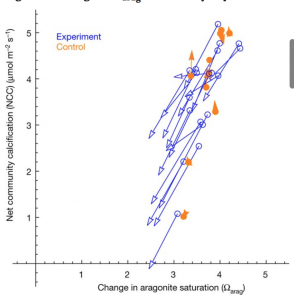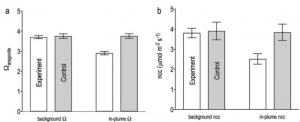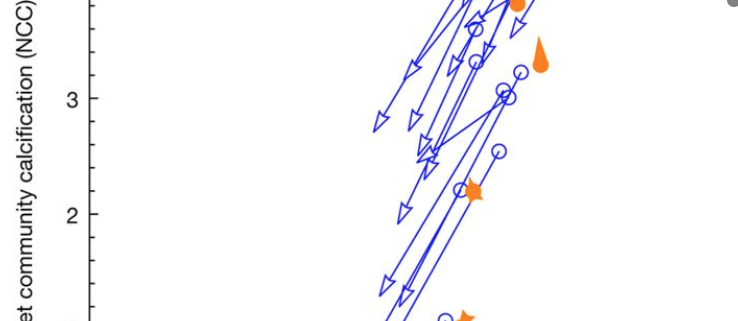Carbon dioxide addition to coral reef waters suppresses net community calcification
By Allison Banas, SRC intern
Coral reefs play a key role in human’s daily lives. Providing food, protection, and income for millions of people worldwide are just a few of the major impacts these ecosystems have (Albright et al. 2016). Ocean acidification can lower the saturation state of aragonite mineral, which composes coral skeletons. Within this century, this acidification may cause a net loss of coral. In the past, net community calcification of coral reefs has been tested using an alkalization experiment, where the aragonite saturation state is restored. These tests have shown that present day rates are depressed compared to the values expected from the past.
Using this information, Albright et al. (2018) tested the hypothesis that near-future reductions in aragonite saturation will significantly impair net community calcification (NCC) at a community scale. The researchers used CO2 gas to increase the CO2 in the seawater flowing over a coral reef to mimic the aragonite saturation levels predicted in this century, then added a dye-tracer to the water, after which a dual tracer regression technique was used to estimate the changes in NCC. This method can compare the active tracer with a passive tracer to assess the alkalinity changes in a system.
Starting with a reef composed of 15% live coral, and 26% crustose algae, once per day for 30 days a tank was deployed and filled with ambient sea water. During 20 of the days, CO2 was bubbled into to the tank to lower the pH of the water. For a control, observations were made when dye but no CO2 was added to test the affects of just the dye. The solutions created were pumped onto the reef, and allowed to flow over the reef. Water samples were taken along a transect and were analyzed for total alkalinity, Rhodamine WT and pH (see Figure 1). Alkalinity-dye measurements from all days were analyzed using a regression approach to create ratios and background alkalinities of the transects while accounting for temporal and spatial variability.

Figure 1: Change in aragonite saturation and NCC by day. Source: Albright et al. 2018
The researchers found that addition of CO2 lowered the aragonite saturation of the water flowing over the reef, and on control days, there was no difference in saturation as compared to background condition. (See figure 2) The null hypothesis that reductions in saturation projected to occur in this century do not impair NCC was rejected via this data and t-tests (experiment: t19=11.26 P < 0.0001 and control t9 = 0.43 P > 0.05). This study takes care to note that comparison of calcification relationships derived from coral studies and mixed-reef communities may be in part from a high abundance of the coralline algae. In this study, it was shown that seawater chemistry influences dissolution as opposed to gross calcification of corals, and sensitivity of NCC to saturation may increase as saturation decreases. This authors concluded that only the reduction of atmospheric CO2 levels will combat ocean acidification.

Figure 2. Mean aragonite saturation and NCC rates for experimental and control days. Source: Albright et al. 2018.
Works cited
Albright, R., Takeshita, Y., Koweek, D. A., Ninokawa, A., Wolfe, K., Rivlin, T., … Caldeira, K. (2018). Carbon dioxide addition to coral reef waters suppresses net community calcification. Nature. doi:10.1038/nature25968
Albright, R., Caldeira, L., Hosfelt, J., Kwiatkowski, L., Maclaren, J. K., Mason, B. M., … Caldeira, K. (2016). Reversal of ocean acidification enhances net coral reef calcification. Nature. doi:10.1038/nature17155



